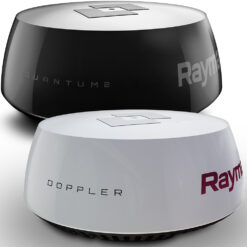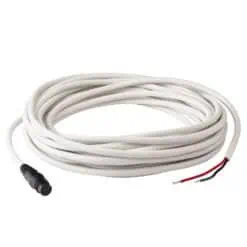
Raymarine Quantum 2 Doppler Radar
£2,079.95 - £2,399.95
Introducing Raymarine Quantum 2 Radar with Doppler collision avoidance technology. The Quantum 2 next generation CHIRP pulse compression radar by Raymarine provides superior target awareness at both long and extremely short ranges.
Using advanced Doppler processing, the system instantly highlights moving radar contacts and color codes them to indicate whether they are inbound or outbound. Quantum with Doppler makes it easy to discern potentially dangerous targets when navigating in high-traffic areas.
You are able to buy the Radar in the follwing options:
E70498 – Quantum 2 Wireless (No Cables) – Requires power cable, see accessories tab
T70416 – Quantum 2 with 10m Power & 10m Data cable.
(Once powered, either radar can be used wirelessly within range. Customers have the option to have a hard connection to their chartplotter or the flexibilty of a wireless connection).
Key Features
- Doppler moving target display allows for superior situational awareness at-a-glance
- Fully automatic MARPA target tracking, along with manual MARPA mode
- Adjustable TrueTrails target history shows the motion history of moving contacts
- CHIRP Pulse Compression detects contacts as close as 18-feet for zero-visibility navigation
- 24-mile range for early detection of traffic, navigation aids, landfall and weather
- Immediate awareness – Quantum starts up and is ready to go in seconds
- Superior interference rejection eliminates noise from other radars
- Simplified installation with Wi-Fi or thin wire network connectivity
- Easy upgrade – Quantum 2 fits the same bolt pattern as other Raymarine scanners
- Lightweight and easy to install – Quantum weighs up to 50% less than comparable magnetron radars
- Safe emissions – mount Quantum anywhere onboard
- Low power consumption for extended battery life under sail
How Doppler Radar Works
Microwave energy waves are bounced off of a distant target, just like conventional radar.
Moving targets send back echoes whose frequencies shift upward or downward from what was originally transmitted.
For inbound targets, the frequency increases as the leading edge of the returning echoes are received more frequently as the target’s range decreases.
For outbound targets, the frequency drops as the returning echoes spread out as its range increases.
Doppler radars are engineered to detect these small shifts in wave frequency, and use them to classify moving radar targets.







